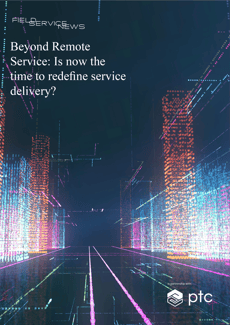The rapid rise of remote service, borne out of necessity, forged in ingenuity.
Apr 01, 2021 • Features • Digital Transformation
In the second of this series of excerpts from a brand new white paper authored by Kris Oldland, Editor-in-Chief, Field Service News published in partnership with PTC, we look at the rise of remote services as a mainstream mechanism for delivering service and maintenance...

This feature is just one short excerpt from an exclusive Field Service News White Paper published in partnership with PTC
www.fieldservicenews.com subscribers can read the full white paper now by hitting the button below.
If you are yet to subscribe you can do so for free by hitting the button and registering for our complimentary subscription tier FSN Standard on a dedicated page that provides you instant access to this white paper PLUS you will also be able to access our monthly selection of premium resources as soo as you are registered.
 Data usage note: By accessing this content you consent to the contact details submitted when you registered as a subscriber to fieldservicenews.com to be shared with the listed sponsor of this premium content PTC who may contact you for legitimate business reasons to discuss the content of this white paper, as per the terms and conditions of your subscription agreement which you opted into in line with GDPR regulations and is an ongoing condition of subscription.
Data usage note: By accessing this content you consent to the contact details submitted when you registered as a subscriber to fieldservicenews.com to be shared with the listed sponsor of this premium content PTC who may contact you for legitimate business reasons to discuss the content of this white paper, as per the terms and conditions of your subscription agreement which you opted into in line with GDPR regulations and is an ongoing condition of subscription.
While the concept of remote service delivery within the field service sector has broken into the mainstream conversation over the last-twelve months, it is far from a new concept. Indeed, it has been a frequently discussed topic amongst many field service organizations for several years.
The arguments for adopting the tools and processes for delivering service remotely are well defined and have been in place far in advance of the most pressing reasons that emerged during 2020 as a result of the pandemic.
As outlined in a Field Service News article from 2019 “The idea behind remote technicians stems from the technician’s ability to diagnose a problem, determine possible solutions, and lay out a plan for issue resolution - all before they take one step onto the worksite. In a perfect world, remote technicians essentially only have to leave their workstations once to perform tasks that require a high level of skill, or perhaps not at all for routine maintenance and repair.
Naturally, this drastically cuts down the amount of travel cost, time and total project duration needed to solve an issue with a customer’s device, streamlining the entire service request from issue detection to resolution.”
Indeed, as we move more and more towards a world of servitization and outcome-based services, where the onus is on the service provider not just to meet an SLA but to consistently minimize any potential asset downtime, remote service is not only an approach to achieve effective service delivery, it is, by necessity, the default approach.
Why? The answer to this lies in the reduction of an important metric tracked by service organizations, mean-time-to-repair (MTTR).
For the field service organization that has adopted a practical remote-first approach to service delivery, the conversation around MTTR is no longer measured in days or even weeks, resolution can now, in essence, be delivered instantly. A recent study by Field Service News Research, that spoke to 145 field service organizations, identified that 89% of these companies stated that much faster response times was a key benefit of adopting a remote-first approach to service delivery.
Even still, the benefits of incorporating remote service capabilities into a field service portfolio are not limited to efficiency gains and cost reductions. There are many other well established and clearly identified benefits of remote service delivery including extended geographical reach, reduced time to get new engineers active in the field, knowledge capture and much more.
In short, the shift to remote service delivery had for many companies already begun, and the reasons for taking this path were becoming increasingly apparent.
Yet, that path was being walked by a relatively small group of companies who were at the leading edge not only in terms of technology, but also in service thinking. However, while the number of companies that were beginning to take that path was steadily increasing, many in the field service sector were yet to follow.
“The shift to remote service delivery had for many companies already begun, and the reasons for taking this path were becoming increasingly apparent...”
This all changed in 2020. As we collectively faced the unprecedented challenges of international lockdowns brought on by the coronavirus pandemic, field service companies were suddenly faced with an entirely new set of challenges. How could we continue to deliver service and maintenance to our customers, many of whom fell within the ‘essential provider’ bracket, while overcoming the new challenge of not violating our clients’ hastily adopted biosecurity measures?
Almost overnight, the need for zero-touch service delivery became omnipresent.
The solution, of course, was the mass adoption of remote service delivery.
Data from Field Service News Research outlined that by September 2020 three quarters (76%) of field service companies now had some form of remote service capabilities. To further drive home how significant the impact of the pandemic was in this shift, over two-thirds of these companies (67%) stated that they implemented these tools as a direct result of the pandemic.
Yet, in a second study by Field Service News Research that dug deeper into what the widespread adoption of remote service delivery means for the field service sector, we found an industry picture that is far from cohesive in defining remote service delivery.
That study showed that of those companies that are delivering service remotely, only 21% are using Augmented Reality while the most commonplace tool used for remote service delivery was the phone (used by 86%). However, it is not just a gulf in tools being used that has emerged within this new frontier of service delivery.
There is much uncertainty around pricing strategies, as well.
In fact, within that same study, we saw that while only 4% of field service companies are charging more for remote service delivery, 35% are not charging for remote service at all, while 31% are charging less.
Of course, due to the sudden introduction of remote-service as a mechanism for service delivery, many companies will have swallowed the cost of remote service within existing contracts, yet, the fact remains, that our industry appears to be somewhat split in how we should accommodate the pricing of remote-service delivery within our service portfolios.
These inconsistencies around the pricing of remote-services is another indicator of the uncertainty within the industry regarding how remote service should be integrated within a service portfolio.
However, if we look at remote-service not in isolation but as a holistic part of a broader service portfolio, we can seize the opportunity to further drive service excellence, which as we shall discuss in the next segment, has proven to be a compelling strategy for revenue growth and competitive advantage.

This feature is just one short excerpt from an exclusive Field Service News White Paper published in partnership with PTC
www.fieldservicenews.com subscribers can read the full white paper now by hitting the button below.
If you are yet to subscribe you can do so for free by hitting the button and registering for our complimentary subscription tier FSN Standard on a dedicated page that provides you instant access to this white paper PLUS you will also be able to access our monthly selection of premium resources as soo as you are registered.
 Data usage note: By accessing this content you consent to the contact details submitted when you registered as a subscriber to fieldservicenews.com to be shared with the listed sponsor of this premium content PTC who may contact you for legitimate business reasons to discuss the content of this white paper, as per the terms and conditions of your subscription agreement which you opted into in line with GDPR regulations and is an ongoing condition of subscription.
Data usage note: By accessing this content you consent to the contact details submitted when you registered as a subscriber to fieldservicenews.com to be shared with the listed sponsor of this premium content PTC who may contact you for legitimate business reasons to discuss the content of this white paper, as per the terms and conditions of your subscription agreement which you opted into in line with GDPR regulations and is an ongoing condition of subscription.
Further Reading:
- Read more from Field Service News Research @ https://research.fieldservicenews.com/
- Read more about Digital Transformation @ https://www.fieldservicenews.com/blog/tag/digital-transformation
- Read more about Service Design and Innovation @ https://www.fieldservicenews.com/blog/tag/service-innovation-and-design
- Read more about Customer Satisfaction and Expectations @ https://www.fieldservicenews.com/blog/tag/customer-satisfaction-and-expectations
- Read more about Remote Service Delivery @ https://www.fieldservicenews.com/hs-search-results?term=REmote+Service
- Read more about the services PTC offer field service companies @ https://www.ptc.com/en/solutions/improving-efficiency/field-service-productivity
- Follow PTC on twitter @ https://twitter.com/PTC
- Read more articles by Kris Oldland @ https://www.fieldservicenews.com/blog/author/kris-oldland
- Connect with Kris Oldland on LinkedIN @ https://www.linkedin.com/in/kris-oldland-49a0171b






















 Field Service News is published by 1927 Media Ltd, an independent publisher whose sole focus is on the field service sector. As such our entire resources are focused on helping drive the field service sector forwards and aiming to best serve our industry through honest, incisive and innovative media coverage of the global field service sector.
Field Service News is published by 1927 Media Ltd, an independent publisher whose sole focus is on the field service sector. As such our entire resources are focused on helping drive the field service sector forwards and aiming to best serve our industry through honest, incisive and innovative media coverage of the global field service sector.
Leave a Reply